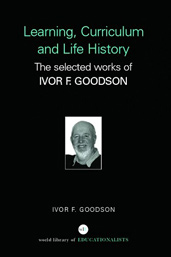Learning, Curriculum and Life Politics: the selected works of Ivor F. Goodson
The Story So Far
Likewise in the world of fantasy, promoted by the movies, stories are the central motif for colonising and re-directing lived experience. This has been so since very early on as the Goldwyn quotes indicate.
A painless way to make sense of this new world was suggested by one of the modernizing forces itself: the movies. The movies offered many forms of guidance to confused Americans, particularly to immigrant urban dwellers; they became a virtual manual for acculturation. But one of the most important and most subtle services the movies offered was to serve as a popular model of narrative coherence. If reality was overwhelming, one could always carve it into a story, as the movies did. One could bend life to the familiar and comforting formulas one saw in the theatre (The New York Times 1991, p. 32).
From the beginning, then, movies began to explore new terrains for formularizing and domesticating reality.
In American life, beginning in the 1920s, a number of media began to exploit the storying theme, first initiated in the movies. The tabloid press and then magazines and television began to provide a range of real life plots from kidnappings and murder to political scandals, to crimes in executive suites, to election campaigns, to World War II, to the cold war, to Watergate, to the recent Soviet coup attempt, to Operation Restore Hope.
Today, virtually all the news assumes a narrative configuration with cause and effect, villain and hero, beginning, middle and provisional end, and frequently a moral. Events that don't readily conform, the savings and loan scandal, for example, seem to drift in foggy limbo like a European art film rather than a sleek commercial American hit (The New York Times 1991, p. 32).
It might be judged that the savings and loan scandal could have been made to conform to a very exciting storyline but it was in fact pushed off into foggy limbo. This raises the key question of the power of storying to make vivid and realistic certain storylines whilst suppressing others, hence, it is clear that murders and fires and kidnappings are exciting material for storylines but that many of the things that go on in American society somehow or other do not form a reasonable storyline. It is interesting, therefore, that so influential a newspaper as The New York Times should see the savings and loan scandal as not worthy of a storyline. They are, in short, accepting the assumptions which underpin the genre.
